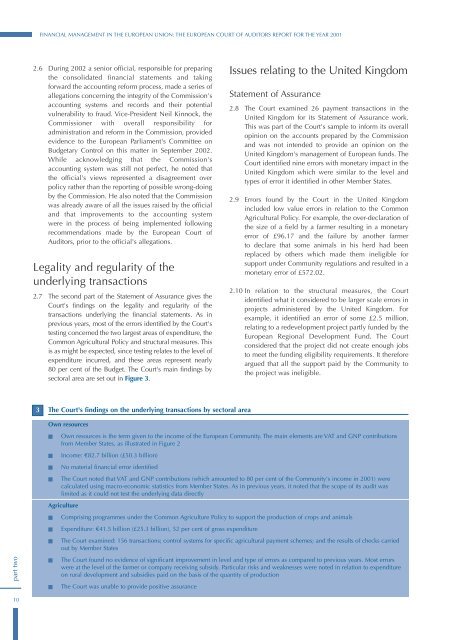Full report - National Audit Office
Full report - National Audit Office
Full report - National Audit Office
Create successful ePaper yourself
Turn your PDF publications into a flip-book with our unique Google optimized e-Paper software.
FINANCIAL MANAGEMENT IN THE EUROPEAN UNION: THE EUROPEAN COURT OF AUDITORS REPORT FOR THE YEAR 2001<br />
2.6 During 2002 a senior official, responsible for preparing<br />
the consolidated financial statements and taking<br />
forward the accounting reform process, made a series of<br />
allegations concerning the integrity of the Commission's<br />
accounting systems and records and their potential<br />
vulnerability to fraud. Vice-President Neil Kinnock, the<br />
Commissioner with overall responsibility for<br />
administration and reform in the Commission, provided<br />
evidence to the European Parliament's Committee on<br />
Budgetary Control on this matter in September 2002.<br />
While acknowledging that the Commission's<br />
accounting system was still not perfect, he noted that<br />
the official's views represented a disagreement over<br />
policy rather than the <strong>report</strong>ing of possible wrong-doing<br />
by the Commission. He also noted that the Commission<br />
was already aware of all the issues raised by the official<br />
and that improvements to the accounting system<br />
were in the process of being implemented following<br />
recommendations made by the European Court of<br />
<strong>Audit</strong>ors, prior to the official's allegations.<br />
Legality and regularity of the<br />
underlying transactions<br />
2.7 The second part of the Statement of Assurance gives the<br />
Court's findings on the legality and regularity of the<br />
transactions underlying the financial statements. As in<br />
previous years, most of the errors identified by the Court's<br />
testing concerned the two largest areas of expenditure, the<br />
Common Agricultural Policy and structural measures. This<br />
is as might be expected, since testing relates to the level of<br />
expenditure incurred, and these areas represent nearly<br />
80 per cent of the Budget. The Court's main findings by<br />
sectoral area are set out in Figure 3.<br />
Issues relating to the United Kingdom<br />
Statement of Assurance<br />
2.8 The Court examined 26 payment transactions in the<br />
United Kingdom for its Statement of Assurance work.<br />
This was part of the Court's sample to inform its overall<br />
opinion on the accounts prepared by the Commission<br />
and was not intended to provide an opinion on the<br />
United Kingdom's management of European funds. The<br />
Court identified nine errors with monetary impact in the<br />
United Kingdom which were similar to the level and<br />
types of error it identified in other Member States.<br />
2.9 Errors found by the Court in the United Kingdom<br />
included low value errors in relation to the Common<br />
Agricultural Policy. For example, the over-declaration of<br />
the size of a field by a farmer resulting in a monetary<br />
error of £96.17 and the failure by another farmer<br />
to declare that some animals in his herd had been<br />
replaced by others which made them ineligible for<br />
support under Community regulations and resulted in a<br />
monetary error of £572.02.<br />
2.10 In relation to the structural measures, the Court<br />
identified what it considered to be larger scale errors in<br />
projects administered by the United Kingdom. For<br />
example, it identified an error of some £2.5 million,<br />
relating to a redevelopment project partly funded by the<br />
European Regional Development Fund. The Court<br />
considered that the project did not create enough jobs<br />
to meet the funding eligibility requirements. It therefore<br />
argued that all the support paid by the Community to<br />
the project was ineligible.<br />
3<br />
The Court's findings on the underlying transactions by sectoral area<br />
Own resources<br />
part two<br />
■<br />
■<br />
■<br />
Own resources is the term given to the income of the European Community. The main elements are VAT and GNP contributions<br />
from Member States, as illustrated in Figure 2<br />
Income: €82.7 billion (£50.3 billion)<br />
No material financial error identified<br />
■ The Court noted that VAT and GNP contributions (which amounted to 80 per cent of the Community's income in 2001) were<br />
calculated using macro-economic statistics from Member States. As in previous years, it noted that the scope of its audit was<br />
limited as it could not test the underlying data directly<br />
Agriculture<br />
■ Comprising programmes under the Common Agriculture Policy to support the production of crops and animals<br />
■ Expenditure: €41.5 billion (£25.3 billion), 52 per cent of gross expenditure<br />
■<br />
■<br />
■<br />
The Court examined: 156 transactions; control systems for specific agricultural payment schemes; and the results of checks carried<br />
out by Member States<br />
The Court found no evidence of significant improvement in level and type of errors as compared to previous years. Most errors<br />
were at the level of the farmer or company receiving subsidy. Particular risks and weaknesses were noted in relation to expenditure<br />
on rural development and subsidies paid on the basis of the quantity of production<br />
The Court was unable to provide positive assurance<br />
10

















